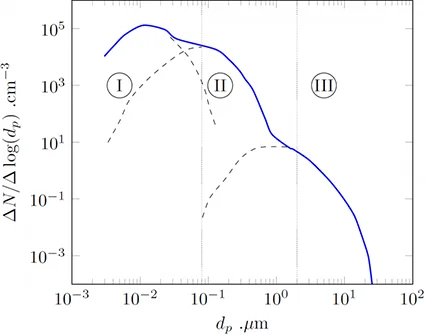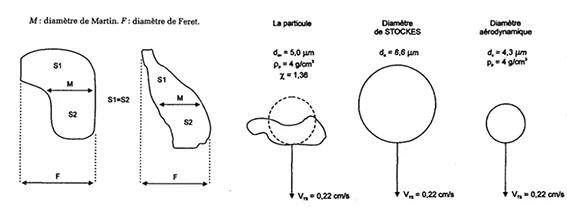Atmospheric aerosol
Origins and properties
Atmospheric aerosols originate from two sources of particulate emissions:
- Natural origin: oceans (sulphate production), fires, volcanoes…
- Anthropogenic origin: particles resulting from human activities. It should be noted that a stationary person emits on average 106 particles with a diameter greater than 0.3 µm per minute! And up to 5.106 particles when travelling at 3 km/h.
The formation of coarse particles (with a diameter greater than 2 µm) is essentially the product of mechanical friction: winds, sand, sea spray and almost always occur only during localized pollution episodes. Their life time is very short: in the order of a few hours for particles larger than 10 µm. Even if their number concentration is often low, their contribution to the mass concentration of the aerosol is nevertheless very important.
Fine particles (diameter less than 2µm) actively participate in the physico-chemistry of the atmosphere. They originate from nucleation or condensation phenomena. Many of these particles do not necessarily result in a significant contribution to the mass of the aerosol.

It is assumed that the atmospheric aerosol is formed by three log-normal distributions:
- the “nucleation” mode (I) which includes particles with diameters of less than 0.08µm,
- the “accumulation” mode (II) made up of particles with diameters between 0.08µm and 2µm,
- the “coarse particle” mode (III) when the dimensions of the particles exceed 2µm.
For instance [R. Jaenicke (1992)]1 proposes a formula to evaluate the residence time of an aerosol based on its particle size and the residence time corresponding to wet disappearances.
Particle diameter
An aerosol is made up of particles whose shape rarely corresponds to the ideal spheres with which we often tend to associate them. It is therefore necessary to define what is meant by “diameter” of a particle (\(d_{\text{p}}\)).
- Martin’s diameter or average string: length of a string dividing the apparent surface of the particle into two equal areas.
- Féret’s diameter: distance between two tangents to the apparent contour of the particle carried out parallel to a fixed direction.
- Stokes’ diameter: diameter of a sphere having the same falling velocity and specific mass as the particle under consideration.
- Aerodynamic diameter: diameter of a sphere having the same falling rate as the particle and a specific mass equal to 1 g.cm-3.
- Projected diameter: diameter of the circle that would have the same surface area as the apparent surface of the particle.

Source: [A. Renoux 1998]2
A more complete description is available on the Albi’s Mines website .
Particle size distribution
It is rare for an aerosol to consist only of particles of the same size. In general, aerosols consist of particles with varying sizes. This is called a polydispersed aerosol . It is therefore necessary to find a statistical interpretation likely to characterize such a granulometric distribution.
One solution is to discretise the interval containing all the component diameters of the aerosol \([d_{\text{min}};d_{\text{max}}]\) into sub-domains of width \(\Delta_p\). The number of particles in each \(\Delta_p\) interval is then counted. This introduces the notion of a class of particles; a class corresponding to an interval \(\Delta_p\).

It may be interesting in practice to approach the granulometry by a continuous function. We will talk about the grain size distribution function. Most often, one or more superimposed laws of type log-normal describe an aerosol. In some cases, it may be interesting to look at the cumulative distribution.
However, in reality, the aerosol granulometry rarely exhibits symmetries. The average is in this case a poor indicator of the diameters constituting the granulometry of an aerosol.